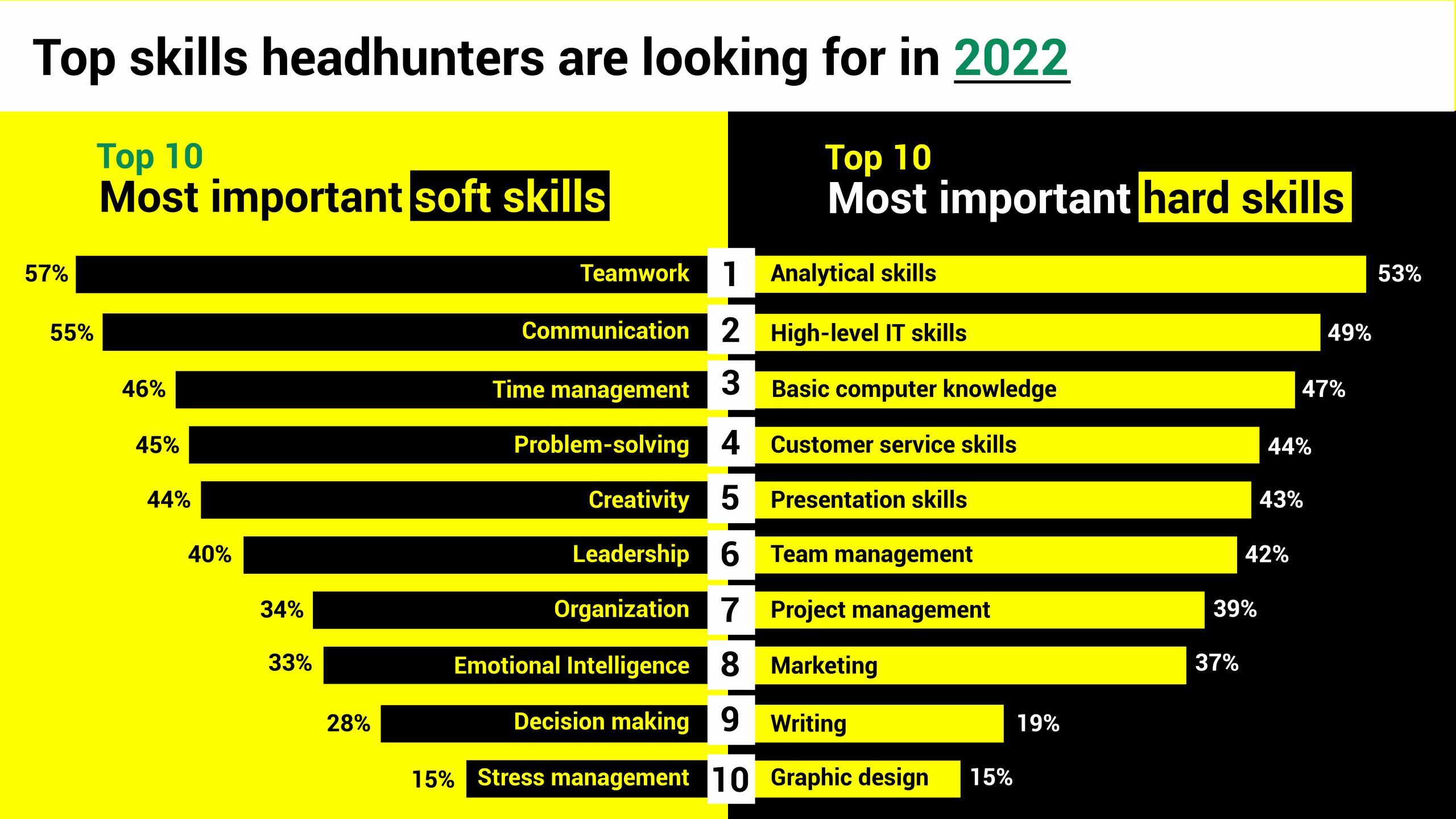If you are being headhunted, stop and pat yourself on the back. Somebody has seen something extraordinary in you and your skill sets that makes you a more attractive proposition over other job candidates. But, what exactly is the X Factor that they are looking for and how can you make sure they come looking for you rather than the other way round?
To find out just what it is that headhunters are looking for, and how potential candidates can make themselves more noticeable and marketable by upskilling and reskilling, Jennifer Bangoura, EdD, Nexford’s Director of Career Innovation, and Paul Breloff, Co-founder and CEO of Shortlist, Africa’s leading recruiting firm and executive search firm ran a very enlightening webinar on the topic.

Headhunters are on the rise
Many people confuse a headhunter with a recruiter or group them together. Too often they are even confused with hiring managers. A headhunter is in fact a specialist and skilled recruiter who works independently but is still on the books of a hiring company. It’s their job to find premium candidates for high-level roles.
So, what are they really looking for you may ask? Well, they are not looking for a temp for a finance firm, or a supermarket employee. 99% of the time, the roles they aim to fill are specialized and highly skilled, often at executive level. These are the positions that aren’t advertised or promoted through standard recruitment channels. If they approach you, know one thing, you have a certain something that they really want. Paul Breloff would know that better than anyone else.
Paul comments, “We help a lot of startups and social impact companies who are having trouble finding the talent they need to grow. In short, we help them find the people with the specialized skills. We do this through executive search. It’s very hands-on and typically focused on positions that require 10 or more years of experience. To date, we have worked with almost 1,000 companies, done about 5,000 placements at this point, and worked with nearly 2 million young people who have been to our platform.”
Learn how to develop the most in-demand skills for your future career!
Discover how you can acquire the most in-demand skills with our free report, and open the doors to a successful career.
Paul is quick to point out to the webinar audience that he recognizes that many candidates are not at executive level yet and to ensure that their talent is not lost, his company frequently carries out talent drives. Here they work with enterprises to help run campus recruitment initiatives or internship programs. They also work with a number of governments and donors to try to help them design and implement programs to solve and address youth employment challenges but also try to unlock the growth of sectors like the climate and clean energy field.
Shortlist also runs a number of programs connecting early college graduates and early career professionals to clean energy and climate companies, as well as trying to connect professionals into remote digital work opportunities. We all know how remote working has exploded post-Covid and is spurning a whole new range of employment opportunities that headhunters are cognisant of.

How the job search world is changing
Recruiters are always hiring, but at the initial stages, they are also eliminating. They are looking at skills on CVs and narrowing down the field all the time. HR people are now using technology and algorithms to separate the wheat from the chaff. They then shift their brains into imagining how a candidate’s future could align with the company and then shift back into hiring mode.
So, you must be permanently thinking of just what it is about you and your qualifications that will make you truly stand out against all the other people in your sector to allow you to get through that first screening. That said it’s not all about you. You also have to be thinking about the person on the other end of the hiring process and how you can make it as easy as possible for them to hire you.

The world has changed and it was already changing before COVID, but it has accelerated during and after COVID into a global and borderless talent market. More companies are open to hiring people anywhere. A true global talent village if you will.
Now you can broaden your world perspective and get amazing global opportunities without leaving your home. And so that’s something to be thinking about for the future like, where do you actually look for jobs? There are a lot of different channels, and you definitely do not need to be hitting all of these to get the job done.
Know what you want and how you are going to get there
What happens when you send your CV into the world to a load of companies? Where does it go? Usually, in most companies, particularly bigger companies and any major corporate, they’ll more often than not go into an applicant tracking system (ATS).
This is a piece of software that processes and stores all applications and uses an algorithm to perform a first pass filter. The program looks for some sense of matching, like what does this person have on their CV such as keywords and other indications that they could possibly be a fit for the job that they’ve applied to. Therefore prior to applying you should go off first and sort your LinkedIn profile out.
You need to know that the first person that is in all likelihood going to see if you are a good fit for the job is a junior HR person and if you get past that screen, it’s probably going to go to a senior HR person. Only then will it go to a hiring manager who actually knows the job. The more junior the HR person, the less they’re going to know if you are really a good match for the role, so you’ll need to make it easy for them. The less complicated your CV the better. Be careful of putting too many layers in. Keep it simple and this will help you to get through the early screening stages.
If you are not on LinkedIn, you are nowhere
Sadly, people don’t see that LinkedIn is an incredibly valuable tool not only for networking, but also for recruiters to find top talent. Job boards are slowly becoming outdated as the meteoric rise of LinkedIn for headhunting continues to grow.
With more than 58 million companies listed on the site and 50 million people searching for jobs on LinkedIn every week, it’s no surprise to find out that 87% of recruiters regularly use LinkedIn. In fact, a study found that 122 million people received an interview through LinkedIn with 35.5 million having been hired by a person they connected with on the site. So, it’s unsurprising that 95 job applications are submitted through LinkedIn every second, and three people are hired every minute.
On that subject Paul says, “If you are not yet on LinkedIn, I would urge you to do this immediately. Today, LinkedIn is more important than a CV recruiters use, so if you are not on it you are not on any headhunter’s radar. If you do use it, it is imperative that you keep it updated all the time. Your goal of LinkedIn is to get someone excited to talk to you, it’s not just to get the job, it’s about securing that interview. And make sure that you have a professional photo of yourself. Profiles with photos get a lot more engagement and views.”
You’ve all heard the term, ‘It’s not what you know, it’s who you know’, so with LinkedIn it is also handy to make sure that you build a bank of connections. Employers aren’t keeping score, but it’s useful to show that you’re active in something like LinkedIn because it shows that you’re digitally savvy, you’re digitally literate, you’re self-aware enough, and marketing savvy enough to go out and build relationships. Even if you just go out and connect with all the people you met through your studies at high school or university that is a start.
Headhunters want to know more about you and your career track record to date, so make sure that you put something into the ‘about section. Ideally, this is like your mini elevator pitch. Put anything you about accomplishments. It’s a missed opportunity if you don’t say anything about what you’ve achieved in the job.
Have an outstanding and simple CV!
Industry research states that on average recruiters spend 6-8 seconds looking at your CV before they decide whether you are suitable for their vacancy or not. Make sure that you hit them between the eyes during that period or your CV will just hit the trash can. Use a simple template and remember that less is more. The standard length of a CV should be two to three pages and make sure it’s readable by an ATS. Look at your CV and change some of the words in it so it matches some of the words in the job description. That’s the type of trick that will get you through that first pass and make sure that a human with some power and decision-making authority sees your CV.

As far as format is concerned, ideally, make sure you’re sending your CV as a PDF. Second best is Microsoft Word. Google Docs can be downloaded very easily as PDFs if you don’t have Word. That’ll make it a lot easier for the machine to keyword match and get you through that first filter.
Also, make sure that you proofread your CV many times and give it to someone else to look at. You won’t believe how many CVs have mistakes that would have been so easy to avoid, where the person may have made it to the next round.
Keep your socials clean and tidy
Besides a watertight CV, these days you also need to make sure that you don’t have any skeletons lurking in your socials closet. Many HR managers will do a simple Google search and see if you do. So, make sure that your socials are squeaky clean.
Keep them private. Do a quick Google search of your name. Make sure it’s nothing freaky. If there is something freaky, there’s different things you can do to typically try to change that. And just think of yourself like your own PR manager. How do you show up to the world?
Also, be really careful of the photos that are up there too, and don’t go online and start trash-talking your employer, as future employers might see that, and they won’t want a person like that on the payroll.
Another way to personalize your application is to email the hiring manager directly. You’ll be surprised as to how many people like this as they see it as proactivity and genuine interest. Go to LinkedIn for the company and try to figure out who is the hiring manager. So, for example, if you’re applying to the data department of Microsoft, in Nairobi, for example, you’d go to LinkedIn and you’d do a filtered search of who works in data in Microsoft, Nairobi. And ideally, you find the actual two or three or four people, and then you just email them.
Learn how to develop the most in-demand skills for your future career!
Discover how you can acquire the most in-demand skills with our free report, and open the doors to a successful career.
Do your homework!
One of the quickest ways to not impress hiring managers and decision-makers is to not know anything about the company you’re hired for. Try to figure out what the role is, what would you actually do? What do you think is the number one priority? What are the key skills and come ready to talk about how your experience fits with those. You should never be surprised to be asked the question, like, why do you want this job?
Also, make sure that you visit the LinkedIn profile of the person who will be interviewing you. If they realize in the first few minutes of the interview that you have not, it shows that you don’t think they are important enough and nine times out of ten, that will be the end of your interview.
If you have done your homework and at the end of the interview, they ask you if you have any questions never ever say no. Some good questions are things about the interviewer’s career journey. What excites them? Some trends you read about in the newspaper, or whatever about that might impact the company? What are the expectations for the job? Things like that.
Last but not least, don’t forget to say, ‘thank you.’ You are giving up your time to attend the interview, but they are giving up theirs and you are not the only person that they will be interviewing.
Ready to take the next step? Download our brochure or book a call with our Nexford Application Specialists!
Subscribe to our newsletter
Don't miss out on our latest updates.
Unlock Your Potential: Explore Our Programs
Invest in yourself and your future. Discover our range of degrees, courses, and certificates to achieve your goal






